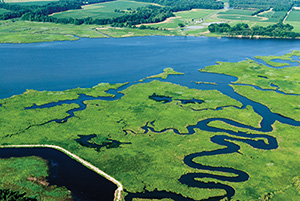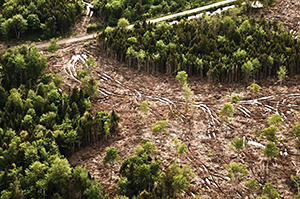
Audubon Adventures

Background for Teachers
Water is many things to us: a natural resource that sustains life, a major aspect of climate and weather, a habitat, a versatile chemical substance, and source of recreation and beauty. More than 70 percent of Earth’s surface is covered in oceans, rivers, lakes, glaciers, and other bodies of water. The atmosphere above and ground below are also filled with water in one or more of its three forms—solid ice, liquid water, and water vapor gas. Water is the only substance that exists in all three forms within Earth’s normal temperatures. Water has a number of other unusual properties. It has an extremely high heat capacity, making it an amazing heat absorber. It has the ability to stick to itself (called surface tension) and pull itself up against gravity (capillary action). Water is also a universal solvent. It can dissolve almost any substance, which is why it’s so important for life.
The water cycle continually recycles Earth’s water. Water evaporated into the air condenses into raindrops, snowflakes, or other forms of precipitation that then fall to the ground and into bodies of water. Rain or melted snow that falls on the ground flows into lakes, rivers, and streams or soaks down into aquifers.
Earth’s waters also regulate its climate and fuel its weather. This is why melting glaciers, rising sea levels, shrinking lakes, and other effects of climate change not only wreak havoc on coastlines and land, but will also change entire weather patterns and the frequency and intensity of storms.
Water literally shapes our planet, cutting out canyons, carving seaside cliffs, and building new land with carried sand and sediment. Glaciers create valleys and grind down mountains. Life itself likely began in an ancient ocean of water. And all life on Earth is made of mostly water—and needs water to exist.
Water is essential to life because it enables essential processes to occur within an organism’s cells. Water is an essential component of photosynthesis, and the chemical reactions that turn food into energy and matter into growth, for example, can take place only in a watery solution. Plants and animals not only need water to live, but many also depend on bodies of water as habitat. Oceans, lakes, wetlands, rivers, and other watery habitats support thousands of species.
Read more.Only about 3 percent of Earth’s water is fresh and only a tiny fraction of that is in rivers and lakes. Most non-salt water is locked up in glaciers or ice caps or held in aquifers. With 97 percent of Earth’s water in salty oceans and seas, that leaves only about 1 percent of all Earth’s water available for our use. It should go without saying that fresh liquid water is a very limited natural resource!
Although the water cycle naturally replenishes Earth’s supply of clean fresh water, natural processes cannot always keep up with human demand. The world’s growing human population uses a lot of water. What we use for drinking, cleaning, cooking, and bathing is just the start. We use far more water in factories and on farmland to produce cars, clothes, paper, and other goods and to grow food. Rivers and lakes supply municipal water, a place to release treated sewage, and produce electricity through hydroelectric dams.
Nations, states, cities, and towns around the world obtain their water by different means. Most use water from lakes, rivers, or aquifers. A few communities collect rainwater or turn seawater into fresh water through desalinization. In the last century, the human population has tripled and its use of water has increased six times. It’s projected that by 2025, nearly three billion people will have to deal with shortages of fresh water. Water conservation by agriculture, industry, cities, and individuals can help make a difference. There are plenty of opportunities to conserve water. For example, toilet flushing in the United States uses more than 4.8 billion gallons of drinking-quality water per day. Every year, the average American flushes about 9,000 gallons of water down the toilet. By using water wisely, we can ensure that everyone gets the water they need.
The wise use of water also includes preventing water pollution. Water pollution is often divided into point sources and nonpoint sources. Point sources have an identifiable and controllable source, such as a sewage outlet flowing into a lake or a factory drain going into a river. Nonpoint sources are less easily controlled and identified, such as water running off dirty oily streets or chemical-covered lawns and farm fields. (The “Helpful or Harmful?” activity in the student magazine has several examples of nonpoint pollution.) Most water pollution comes from industrial waste, sewage, and nonpoint sources such as runoff from farms and city streets. This pollution harms the health of human communities and poisons ecosystems, and because we use water again and again, polluted water has to be purified before it can be safely used again.
Unfortunately, many countries don’t do a very good job of preventing water pollution or purifying their water, so people who live there often get sick or even die from drinking polluted water.
Photos:(t to b) kahj19/iStock; Matt Rath/Chesapeake Bay Program/Flickr Creative Commons; iStock.






